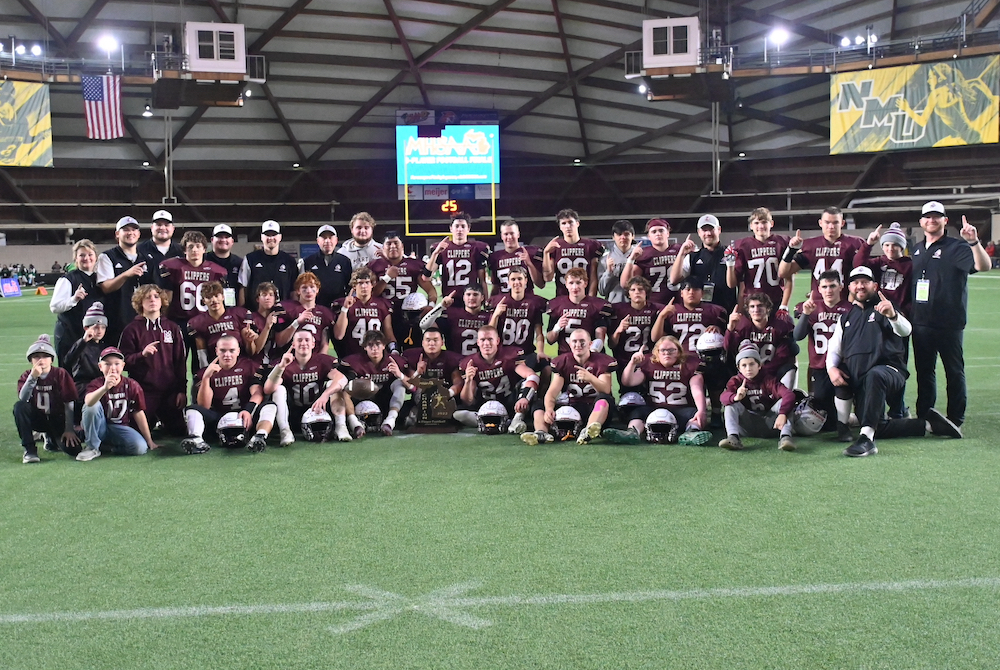
Thank Roosevelt for Football Weekends
December 20, 2013
By Rob Kaminski
MHSAA benchmarks editor
The next time you find yourself immersed in a tense crosstown football rivalry on a Friday night followed by a Saturday pilgrimage to the nearest college campus and a Sunday afternoon with a remote and your favorite snacks and beverages, take a moment to consider what the weekend would be like if it weren’t for Teddy Roosevelt.
The man who became our 26th President shortly after the turn of the 20th Century following the assassination of William McKinley in 1901 was a football fan like you. Maybe more so.
Today’s game of football has reached a critical crossroads. Player size and speed have increased across the board. Savage use of equipment as weapons rather than protective gear has been glorified on television networks and social media. Leaders of the game at all levels have recognized the need for change, employing new rules and widespread educational efforts to aid in preserving the sport.
History, as they say, is repeating itself.
In an ironic twist, it was Roosevelt who saved the then-brutally violent game of football from itself more than 100 years ago. Yes, the same “Rough and Ready Teddy” who led the charge up San Juan Hill during the Spanish-American War and often sparred in the boxing ring while in office from 1901-09 opined that football was becoming so gruesome that he delivered an ultimatum: clean up the game or it would be outlawed.
The Chicago Tribune reported that in 1904 alone, there were 18 football deaths and 159 serious injuries, mostly among prep school players. Football deaths suffered by younger players were reported on a nearly weekly basis, as outraged citizens called on colleges and high schools to banish football outright.
In stepped Roosevelt, who called head coaches and representatives from Harvard, Yale and Princeton – college powers at the time – to the White House in 1905 urging them to eliminate excessive violence and set an example of fair play for the rest of the country. When the casualties actually rose by one during the ensuing season, Roosevelt reacted with greater resolve and convened leading football authorities for the purpose of authoring drastic rules changes. What emerged was an intercollegiate conference which was the predecessor of the NCAA.
Among the most effective changes for the 1906 season were the legalization of the forward pass, the elimination of mass formations, and the creation of a neutral zone. Football fatalities fell to 11 in each of the next two seasons, and severe injuries fell drastically.
Thanks to the introduction of protective equipment and ever-evolving rules changes, football during the 100-plus years to follow has become an exponentially safer game. Yet, the game’s leaders always will need to adjust and react to scrutiny that comes with the territory.
So, as the game once again undergoes rules modifications in the name of safety, give a tip of the cap to President Roosevelt while you enjoy college bowl season and the NFL playoffs and begin to think ahead to the first high school practice of 2014.

Team of the Month: Martin Football
By
Geoff Kimmerly
MHSAA.com senior editor
December 13, 2022
Two straight trips to 8-Player Semifinals
 Two seasons over the last three with double-digit wins.
Two seasons over the last three with double-digit wins.
Three straight seasons where the only loss on the field came in the playoffs to the eventual Division 1 champion.
Martin’s football team had come so close a few times to earning the ultimate prize in Michigan high school football. And finally, this fall, it was the Clippers’ turn.
Paced by 11 seniors, the MHSAA/Applebee’s “Team of the Month” for November claimed the 8-Player Division 1 championship at the Superior Dome in Marquette – the Clippers’ first Finals title since 1987 – with a 74-24 win over previously-undefeated Merrill.
“This is the most seniors we’ve ever had, as long as I’ve been coaching here,” said Martin coach Brad Blauvelt, a 2003 graduate of the school who just finished his fifth season leading the program after serving as an assistant coach nearly as long before taking over. “Program kids – from rocket football to middle school, all the way up, they’ve been committed to the program the whole time.”
Martin has an interesting recent history as a program, to say the least. After five straight winning seasons from 2003-07, the Clippers didn’t win a game from 2008-2013. They got back on the plus side at 6-4 in 2018, then made the move to 8-player – where they’ve gone a combined 40-6 over the last four seasons.
This one started with a 30-28 win over Mendon – the eventual 8-Player Division 2 runner-up – and over 13 games Martin averaged 54 points while giving up only 14.5. There were a pair of losses along the way – to Grand Rapids NorthPointe Christian and Bridgman, which both finished 9-0 but have enrollments too high to qualify for the 8-Player Playoffs. Those losses helped Martin move forward, especially the 35-34 defeat against Bridgman in the regular-season finale.
“The biggest thing was being OK with a loss, because we were so used to winning … not being OK with it, just understanding we’ll get better from it,” Blauvelt said.
The Bees were able to get their playmakers outside on the Clippers – which generally means big plays in the 8-player format. So Martin’s coaches made a sharp adjustment heading into the postseason, putting all-state safety Sam Jager at one outside linebacker, and moving middle linebacker (and all-state quarterback) JR Hildebrand outside on the other side.
So while Hildebrand was able to continue leading the offense to totals of 68, 56, 42 and 74 points over the four playoff games, the Clippers during the playoffs gave up just 52 points total – and held a two-time reigning champion Adrian Lenawee Christian team averaging 48 points per game to just 14 in a 59-14 Regional Final win.
The Cougars had eliminated Martin from the playoffs the last two Semifinals on the way to those two straight Division 1 championships. In 2019, Martin lost to Colon in a Regional Final, and the Magi went on to claim the Division 1 title.
“The last couple of years, we lost the last game of the season, and you can’t do anything about it,” Blauvelt said. “Losing in-season, we were able to fix and change some things around that I think ultimately helped us.”
Hildebrand was one of the state’s best at his position this fall, rushing for 1,340 yards and 23 touchdowns and throwing for 1,234 yards and 25 scores. He owns two school records on offense, and also led the team with 90 tackles, to go with four sacks and seven more tackles for loss.
Jager caught seven of those touchdown passes and was the best blocker for a team that ran for more than 2,600 yards. He had 51 tackles and five interceptions, including one he brought back for a score. Another senior, Karter Ribble, topped 300 yards rushing and receiving, with a combined 12 touchdowns, plus scored twice on kickoffs and again on a punt return. He also made 90 percent of his extra-point tries and set a school record with a 43-yard field goal.
They were part of that senior class that, although graduating, has helped bring a buzz and momentum that Blauvelt hopes carries over into other sports, academics and the community as a whole.
“They come to morning workouts, they come to all the summer stuff, and they do the extra work to push themselves over the hump,” Blauvelt said. “They’re so talented athletically too, that doing that pushed them over the top even more so.”
Past Teams of the Month, 2022-23
October: Gladwin volleyball - Report
September: Negaunee girls tennis - Report

